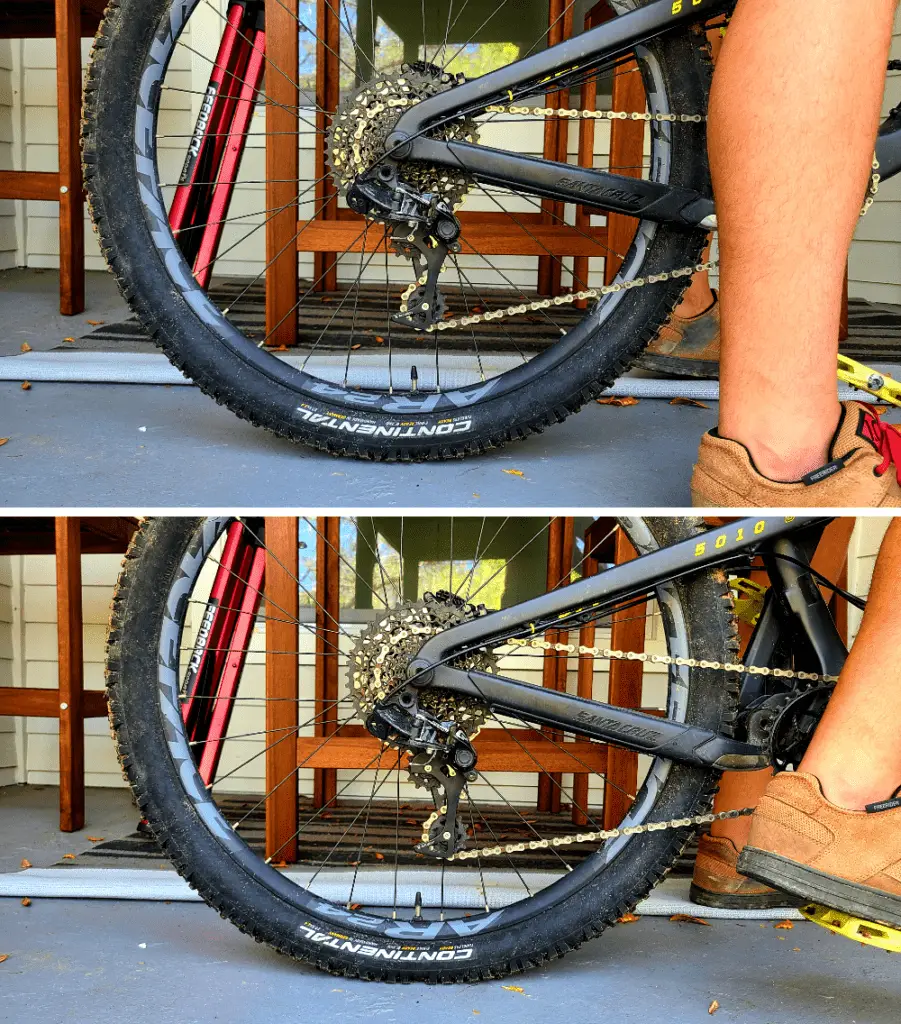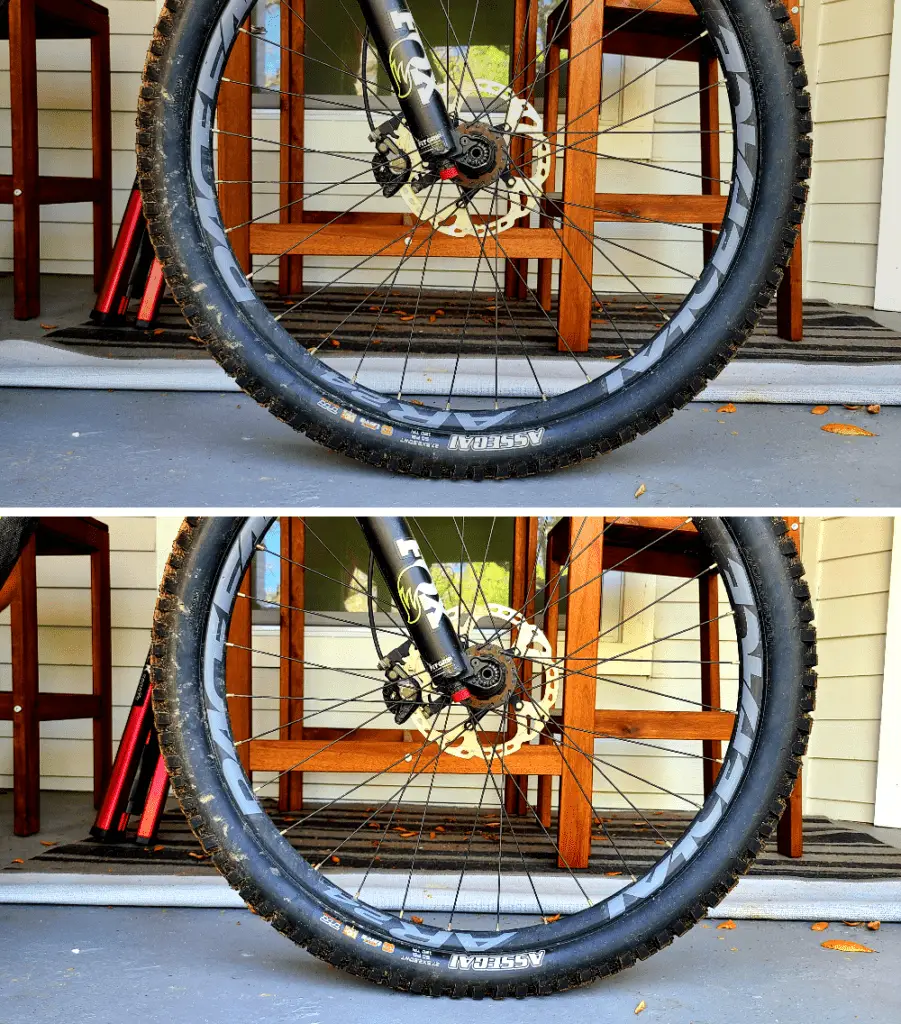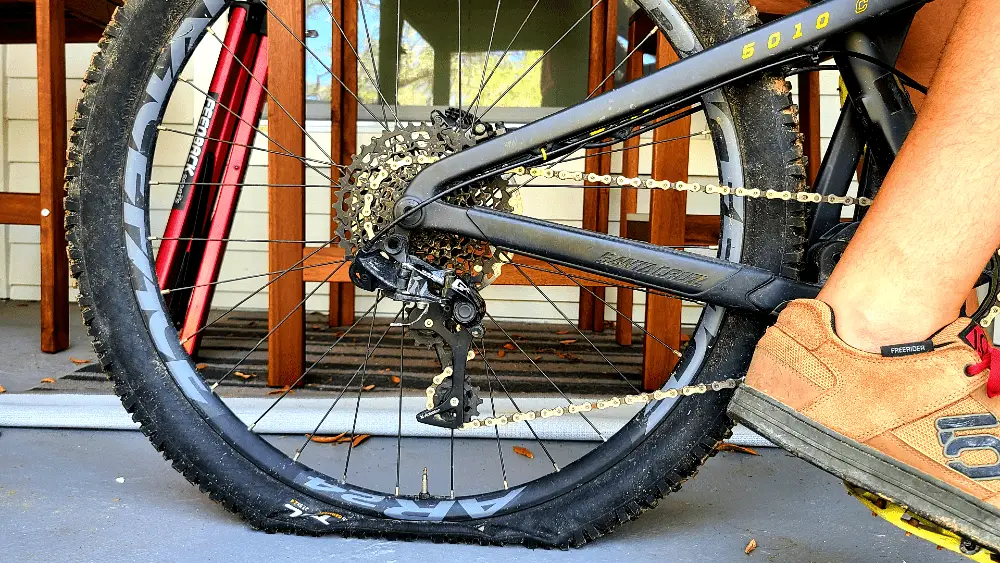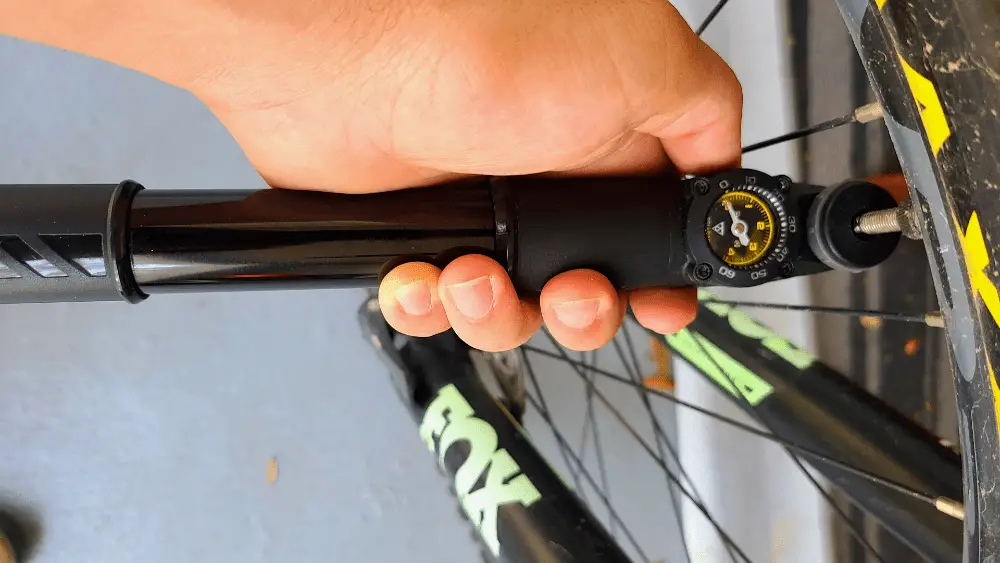Mountain bike tires aren’t pumped up to pressures anywhere near as high as road bike tires. In fact, when you see the pressures most mountain bikers run in their tires, you’d probably think they’re underinflated!
So how should these bike tires look when properly inflated?
How Bike Tires Should Look When Riding

When properly inflated, mountain bike tires will have some give to them and squish a bit when you’re sitting in the saddle. As more of your body weight will be over the rear tire, it will appear to squish much more than the front tire will. This is normal and does not mean your rear tire is underinflated.
Mountain bike tires are required to provide much more traction over a variety of surfaces compared to road bike tires. When they’re able to squish a bit, more of the tire can be in contact with the ground at any given time. More ground contact means better grip.
Before we really get into what your mountain bike tires should look like when properly inflated, we need to know what “properly inflated” even means…because the amount of air pressure I put in my tires will probably be different than yours.
Proper tire pressure comes down to a variety of factors, such as: your weight; your riding style; the types of trails you ride; tire diameter, width and casing; rim width; and whether you use inner tubes or not.
That’s a lot to factor in! Luckily, there are many great tire pressure calculators that will help get you started: then it’s all about making small tweaks to find the pressure that works best for you.
So once you have your tire pressure set, what should your tires look like when riding?
To test this out, first make sure to put on whatever riding gear you normally wear: your tires will look much different with the extra weight of your gear (including a hydration pack full of water) compared to when you’re just wearing a pair of shorts!
While standing over your bike, lower your weight onto the saddle and put your feet on the pedals (balancing yourself against a wall if needed). Take a look down at your rear tire: you should notice the sidewalls bow out just a bit…maybe by a few millimeters or so. It will be subtle but definitely noticeable.

This won’t be as noticeable on your front tire. Since less of your body weight is over your front tire, it won’t squish as much…but you’ll still be able to see it if you watch closely.

Additionally, since it isn’t required to support as much of your body weight, your front tire can be inflated a couple pounds per square inch (psi) less than your rear tire. This improves traction and braking performance (which your front tire is mostly responsible for) without sacrificing rolling efficiency.
How Bike Tires Should Look without a Rider
When you’re not in the saddle, your bike tires should look perfectly round, as if they were filled to the maximum air pressure listed on the sidewall of the tire. Since there’s no added body weight pushing down on the tires, they shouldn’t sag at all.
Most mountain bikes weigh somewhere in the 28-40lb range (or higher if you have an e-bike): but even bikes on the heavier end of the spectrum shouldn’t weigh enough to cause the tires to compress. If your tires do compress under the weight of only your bike, they’re underinflated!
Are Bike Tires Supposed to Look Flat?

Bike tires will squish to some degree when you put your weight on the pedals. This will be way more pronounced if you have 29er tires with a more durable casing and run them tubeless: three factors that allow you to use considerably less air pressure. But even so, bike tires are not supposed to look flat. If yours do, they’re probably severely underinflated.
Tires this underinflated won’t roll very well, aren’t sturdy enough to corner on, and won’t provide much protection for your rims. Even if you use a tire insert like CushCore, which lets you run ridiculously low tire pressure, your tires still shouldn’t look completely flat.
Are Bike Tires Supposed to Be Hard?
Let’s look at the opposite end of the spectrum. Mountain bike tires are not supposed to be so inflated that they don’t give at all when you squeeze them with your hand. Though the maximum inflation rating for mountain bike tires is much less than road bike tires, there’s never a reason you’d want to inflate your tires to the maximum when trail riding.
If your tires feel that firm, they’ll roll very efficiently…but won’t bite into the ground very well, limiting their ability to provide traction. Rather than being able to control where you’re going, you’ll feel like you’re sliding around on the trail. Depending on the terrain you’re riding, this could be quite a scary feeling!
Where road bike tires are typically inflated above 90psi, mountain bike tires on average are inflated to only 30psi or less. This means your mountain bike tires shouldn’t feel hard. When pinching the tire between your fingers, the tire should have some noticeable give to it.
Check out our previous article on the dangers of over or underinflating your tires for more.
How to Tell if Bike Tires Are Properly Inflated (the Best Way)

Inflating your tires to the proper pressure is one of the most important things you can do before every ride. Different terrain or weather may call for different tire pressures, and making sure you’ve got your tire pressure dialed will make a huge impact on your riding performance.
However, even if you only ever ride the same terrain, you can’t just set your tire pressure at the beginning of the riding season and then forget about it, since tires will lose air over time (especially tubeless tires).
So what’s the best way to check to make sure your tire pressure is correct before you ride?
Check your tires with a tire pressure gauge! This is the most effective way to guarantee your tires are properly inflated. You could buy a tire pressure gauge, but you probably already have one: most tire pumps (even handheld pumps meant to fit in your riding pack) have a pressure gauge on them. There’s really no reason not to use one before every ride.
If you’re a pro, you can probably tell your tires are properly inflated just by sitting on your bike and checking how much they compress. But I know I probably couldn’t tell the difference between a tire inflated to 28psi (my preferred rear tire pressure) and one inflated to 23psi just by looking at it…and 5psi will have a significant effect on the way your bike handles.
So do yourself a favor and take the extra minute to check your tire pressure with a gauge before every ride. It will improve your riding performance and might even save you from a crash.
